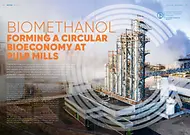SCALING UP TECHNOLOGY
The exciting new development continued as a feasibility study project of Södra’s, working with Invico Metanol as consultants and a pilot plant was built at the Mönsterås mill to further develop the process. “We built a container solution for the pilot plant next to the mill,” says Sjöblom. “And added three small columns for the refining and extraction process. It was soon proved that this was a viable enterprise, and the decision was taken in 2016 to industrialize the process and make our own biomethanol at the mill for commercial purposes.”
One of the crucial phases in moving from successful demonstration apparatus into full commercialization is the scaling up of the technology. Södra initially planned to carry out the project on its own, however this period coincided perfectly with the purchase of Invico Metanol’s patents for biomethanol extraction technology by ANDRITZ.
“This was a crucial point,” says Sjöblom. “We could have taken the whole project on by ourselves, but now with ANDRITZ involvement we knew we had a partner that could take on the whole project and deliver the complete plant.”
After a lot of discussion and planning a contract was finally set in March 2018 and work began. “This was a really exciting, but also demanding phase of the project, we were all learning as we went along such was the new, uncharted territory we were venturing into.
There was a lot of learning taking place as we progressed, both on the ANDRITZ side and with our project team.”
Södra took responsibility with the building and ANDRITZ with the scaling up of the technology as well as designing and building the process equipment for the project. All parties involved with the project utilized 3D design technology, Södra, ANDRITZ, and the construction company involved and it was soon realized that the existing building was not big enough for the upscaled technology.
“We had to change the design and expand the building, which caused us a short delay,” adds Sjöblom.
Joakim Johansson, ANDRITZ Commissioning & Start-up Manager, says, “I came to take over the project for commissioning and start-up in August 2019, and there was still some design changes going on at that stage. This was a time when ANDRITZ engineers and Södra operators were working very closely together, and we were learning a lot.
“Obviously with a new concept like this there were parts of the operation and problems we could not foresee until we actually tried them. But we overcame the challenges as they arose and together made it work. This was a real cooperation success between the operators and ANDRITZ.”
The first start-up of the biomethanol plant with raw methanol being introduced into the plant was in November 2019, and all went remarkably well considering it was a totally new concept. “It all went quite smoothly considering the task at hand, there were a lot of different disciplines converging in one place.
“After a short break at Christmas, and a few teething problems when starting up in January, we very soon saw good quality biomethanol coming out of the plant. Like all plants of this kind, they are built to run, and its only by continuous running that you achieve the stability desired,” says Sjöblom.
Egon Paltmann, Project Manager, ANDRITZ, responsible for the biomethanol plant project at Mönsterås, says, “This was no normal project and there were no previous examples to follow. This biomethanol plant is a totally new concept from top to bottom, so we had something of a rollercoaster ride during the project, with lots of learning and some ups and downs on the way.
“However, we had a small group of people constantly working on this project, and it was the total dedication of this team – both from Södra and ANDRITZ – that made this project a success.”







